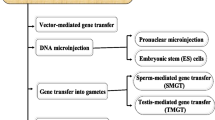Abstract
The low efficiency of transgenic animal production by microinjection has been a serious problem especially for the production of transgenic livestock. We developed a method to selectively produce transgenic mice using green fluorescent protein (GFP) as a marker. Using this method, we obtained eight fetuses and four live-born mice derived from 55 GFP-positive blastocysts. PCR analysis showed 11 out of 12 mice (fetuses and newborn mice) were transgenic. Southern blot analysis showed that 8 out of 12 were transgenic. GFP expression was also observed in bovine blastocysts, suggesting that this method should contribute to the efficient production of transgenic livestock.
Similar content being viewed by others
References
Brinster, R.L., Chen, H.Y., Trumbauer, M.E., Yagle, M.K., and Palmiter, R.D. 1985. Factors affecting the efficiency of introducing foreign DNA into mice by microinjecting eggs. Proc. Natl. Acad. Sci. USA 82: 4438–4442.
Hammer, R.E., Pursel, V.G., Rexroad, C.E. Jr., Wall, R.J., Bolt, D.J., Ebert, K.M. et al. 1985. Production of transgenic rabbits, sheep and pigs by microinjection. Nature 315: 80–683.
Cubitt, A.B., Heim, R., Adams, S.R., Boyd, A.E., Gross, L.A., and Tsien, R.Y. 1995. Understanding, improving and using green fluorescent proteins. Trends Biochem. Sci. 20: 448–455.
Thompson, E.M., Adenot, P., Tsuji, F.I., and Renard, J.-P. 1995. Real time imaging of transcriptional activity in live mouse preimplantation embryos using a secreted luciferase. Proc. Natl. Acad. Sci. USA 92: 1317–1321.
Ikawa, M., Kominami, K., Yoshimura Y., Tanaka, K., Nishimune, Y., and Okabe, M. 1995. A rapid and non-invasive selection of transgenic embryos before implantation using green fluorescent protein (GFP). FEBS Lett. 375: 125–128.
Hanaoka, K., Hayasaka, M., Uetsuki, T., Fujisawa-Sehara, A., and Nabeshima, Y. 1991. A stable cellular marker for the analysis of mouse chimeras: the bacterial chloramphenicol acetyltransferase gene driven by the human elongation factor 1 a promoter. Differentiation 48: 183–189.
Oshima, M., Oshima, H., Kobayashi, M., Tsutsumi, M., and Taketo, M.M. 1995. Evidence against dominant negative mechanisms of intestinal polyp formation by Ape gene mutations. Cancer Res. 55: 2719–2722.
Niwa, H., Yamamura, K., and Miyazaki, J. 1991. Efficient selection for high-expression transfectants with a novel eukaryotic vector. Gene 108: 193–200.
Ikawa, M., Kominami, K., Yoshimura, Y., Tanaka, K., Nishimune, Y., and Okabe, M. 1995. Green fluorescent protein as a marker in transgenic mice. Develop. Growth Differ. 37: 455–459.
King, D. and Wall, R.J. 1988. Identification of specific gene sequences in preimplantation embryos by genomic amplification: detection of a transgene. Mol. Reprod. Develop. 1: 57–62.
Ninomiya T., Hoshi, M., Mizuno, A., Nagao, M., and Yuki, A 1989. Selection of mouse preimplantation embryos carrying exogenous DNA by polymerase chain reaction. Mol. Reprod. Develop. 1: 242–248.
Heim, R., Cubitt, A.B., and Tsien, R.Y. 1995. Improved green fluorescence. Nature 373: 663–664.
Kim, D.W., Uetsuki T., Kaziro, Y., Yamaguchi, N., and Sugano, S. 1990. Use of the human elongation factor 1 a promoter as a versatile and efficient expression system. Gene 91: 217–223.
Uetsuki, T., Naito, A., Nagata, S., and Kaziro, Y. 1989. Isolation and characterization of the human chromosomal gene for polypeptide chain elongation factor 1α. J. Biol. Chem. 264: 5791–5798
Hogan, B., Beddington, R., Costaniti, F., and Lacy, E. 1994. pp. 232–248 in Manipulating the mouse embryo: a laboratory manual. 2nd ed. Hogan, B., Beddington, R., Costaniti, F, and Lacy, E. (eds). Cold Spring Harbor Laboratory Press, Cold Spring Harbor, NY.
Brackett, B.G. and Oliphant, G. 1975. Capacitation of rabbit spermatozoa in vitro. Biol. Reprod. 12: 260–274.
Takahashi, Y. and First, N.L. 1992. In vitro development of bovine one-cell embryos: influence of glucose, lactate, pyruvate, amino acids and vitamins. Theriogenology 37: 963–978.
Church, G.M. and Gilbert, W. 1984. Genomic sequencing. Proc. Natl. Acad. Sci. USA 81: 1991–1995.
Author information
Authors and Affiliations
Corresponding author
Rights and permissions
About this article
Cite this article
Takada, T., lida, K., Awaji, T. et al. Selective production of transgenic mice using green fluorescent protein as a marker. Nat Biotechnol 15, 458–461 (1997). https://doi.org/10.1038/nbt0597-458
Received:
Accepted:
Issue Date:
DOI: https://doi.org/10.1038/nbt0597-458
- Springer Nature America, Inc.
This article is cited by
-
Efficient transformation of the isolated microspores of Chinese cabbage (Brassica rapa L. ssp. pekinensis) by particle bombardment
Plant Methods (2024)
-
Rapid titration of retroviral vectors using a β-lactamase protein fragment complementation assay
Gene Therapy (2013)
-
Establishment of testicular and ovarian cell lines from Honmoroko (Gnathopogon caerulescens)
Fish Physiology and Biochemistry (2013)
-
The importance of being red
Nature Biotechnology (2009)
-
Transgene expression of enhanced green fluorescent protein in cloned rabbits generated from in vitro-transfected adult fibroblasts
Transgenic Research (2009)





